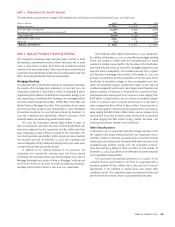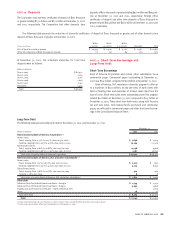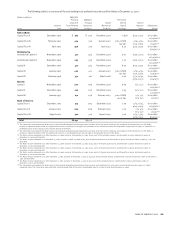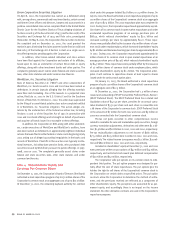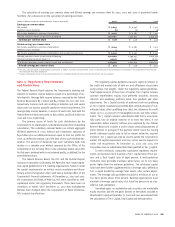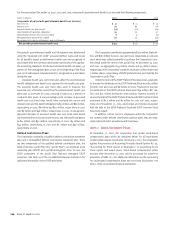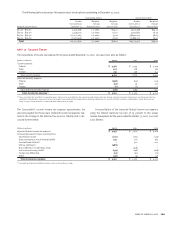Bank of America 2002 Annual Report Download - page 101
Download and view the complete annual report
Please find page 101 of the 2002 Bank of America annual report below. You can navigate through the pages in the report by either clicking on the pages listed below, or by using the keyword search tool below to find specific information within the annual report.
BANK OF AMERICA 2002 99
The calculation of earnings per common share and diluted earnings per common share for 2002, 2001 and 2000 is presented below.
See Note 1 for a discussion on the calculation of earnings per share.
(Dollars in millions, except per share information; shares in thousands)
2002 2001 2000
Earnings per common share
Net income $ 9,249 $ 6,792 $ 7,517
Preferred stock dividends (5) (5) (6)
Net income available to common shareholders $ 9,244 $ 6,787 $ 7,511
Average common shares issued and outstanding 1,520,042 1,594,957 1,646,398
Earnings per common share $6.08 $ 4.26 $ 4.56
Diluted earnings per common share
Net income available to common shareholders $ 9,244 $ 6,787 $ 7,511
Preferred stock dividends 556
Net income available to common shareholders and assumed conversions $ 9,249 $ 6,792 $ 7,517
Average common shares issued and outstanding 1,520,042 1,594,957 1,646,398
Dilutive potential common shares(1,2) 45,425 30,697 18,531
Total diluted average common shares issued and outstanding 1,565,467 1,625,654 1,664,929
Diluted earnings per common share $ 5.91 $ 4.18 $ 4.52
(1) For 2002, 2001 and 2000, average options to purchase 22 million, 85 million and 108 million shares, respectively, were outstanding but not included in the computation of earnings per
share because they were antidilutive.
(2) Includes incremental shares from assumed conversions of convertible preferred stock, restricted stock units and stock options.
NOTE 15 Regulatory Requirements
and Restrictions
The Federal Reserve Board requires the Corporation’s banking sub-
sidiaries to maintain reserve balances based on a percentage of cer-
tain deposits. Average daily reserve balances required by the Federal
Reserve Board were $3.7 billion and $4.0 billion for 2002 and 2001,
respectively. Currency and coin residing in branches and cash vaults
(vault cash) are used to partially satisfy the reserve requirement. The
average daily reserve balances, in excess of vault cash, held with the
Federal Reserve Bank amounted to $95 million and $128 million for
2002 and 2001, respectively.
The primary source of funds for cash distributions by the
Corporation to its shareholders is dividends received from its banking
subsidiaries. The subsidiary national banks can initiate aggregate
dividend payments in 2003, without prior regulatory approval, of
$4.6 billion plus an additional amount equal to their net profits for
2003, as defined by statute, up to the date of any such dividend dec-
laration. The amount of dividends that each subsidiary bank may
declare in a calendar year without approval by the Office of the
Comptroller of the Currency (OCC) is the subsidiary bank’s net profits
for that year combined with its net retained profits, as defined, for the
preceding two years.
The Federal Reserve Board, the OCC and the Federal Deposit
Insurance Corporation (collectively, the Agencies) have issued regula-
tory capital guidelines for U.S. banking organizations. Failure to meet
the capital requirements can initiate certain mandatory and discre-
tionary actions by regulators that could have a material effect on the
Corporation’s financial statements. At December 31, 2002 and 2001,
the Corporation and Bank of America, N.A. were classified as well-
capitalized under this regulatory framework. There have been no
conditions or events since December 31, 2002 that management
believes have changed either the Corporation’s or Bank of America,
N.A.’s capital classifications.
The regulatory capital guidelines measure capital in relation to
the credit and market risks of both on- and off-balance sheet items
using various risk weights. Under the regulatory capital guidelines,
Total Capital consists of three tiers of capital. Tier 1 Capital includes
common shareholders’ equity, trust preferred securities, minority
interests and qualifying preferred stock, less goodwill and other
adjustments. Tier 2 Capital consists of preferred stock not qualifying
as Tier 1 Capital, mandatory convertible debt, limited amounts of sub-
ordinated debt, other qualifying term debt, the allowance for credit
losses up to 1.25 percent of risk-weighted assets and other adjust-
ments. Tier 3 capital includes subordinated debt that is unsecured,
fully paid, has an original maturity of at least two years, is not
redeemable before maturity without prior approval by the Federal
Reserve Board and includes a lock-in clause precluding payment of
either interest or principal if the payment would cause the issuing
bank’s risk-based capital ratio to fall or remain below the required
minimum. Tier 3 capital can only be used to satisfy the Corporation’s
market risk capital requirement and may not be used to support its
credit risk requirement. At December 31, 2002 and 2001, the
Corporation had no subordinated debt that qualified as Tier 3 capital.
To meet minimum, adequately capitalized regulatory require-
ments, an institution must maintain a Tier 1 Capital ratio of four per-
cent and a Total Capital ratio of eight percent. A well-capitalized
institution must generally maintain capital ratios 100 to 200 basis
points higher than the minimum guidelines. The risk-based capital
rules have been further supplemented by a leverage ratio, defined as
Tier 1 capital divided by average total assets, after certain adjust-
ments. The leverage ratio guidelines establish a minimum of 100 to
200 basis points above three percent. Banking organizations must
maintain a leverage capital ratio of at least five percent to be clas-
sified as well-capitalized.
Unrealized gains on available-for-sale securities and marketable
equity securities and the net gains (losses) on derivatives included in
shareholders’ equity at December 31, 2002 and 2001 are excluded from
the calculations of Tier 1 Capital, Total Capital and leverage ratios.


